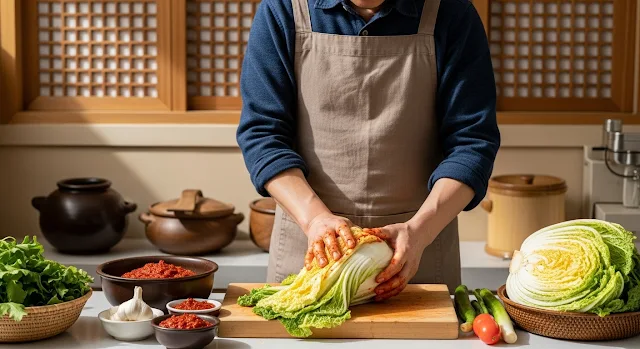Kimchi: Fermentation, Variety, and Legacy
If there’s one dish that defines Korean cuisine, it’s kimchi. Spicy, tangy, and deeply rooted in tradition, kimchi is more than a side dish — it’s a national symbol, a family ritual, and a fermented powerhouse of flavor and nutrition.
In this third episode of our Korean food series, we uncover the story of kimchi — from its countless variations to the cultural significance of its seasonal preparation.
1. What Is Kimchi?
Kimchi (김치) is a fermented vegetable dish, most commonly made with napa cabbage and seasoned with garlic, chili powder, fish sauce, and salted shrimp. But that’s just the beginning — there are over 200 known types of kimchi across Korea.
What defines kimchi is not just its ingredients, but its process: salt, season, ferment. This transforms simple vegetables into something complex, alive, and essential to Korean meals.
2. Types of Kimchi
While cabbage kimchi (baechu kimchi) is the most iconic, there are many regional and seasonal varieties, including:
- Kkakdugi: Cubed radish kimchi, crunchy and spicy-sweet.
- Baek kimchi: White kimchi without chili, mild and refreshing.
- Buchu kimchi: Made with garlic chives and often eaten with grilled meats.
- Yeolmu kimchi: Young radish kimchi, popular in summer and served in cold noodles.
Each region has its own twist — coastal towns may add seafood, while mountainous areas favor herbs and root vegetables.
3. Health Benefits of Kimchi
Kimchi is not only delicious — it’s good for you. Rich in probiotics, vitamins A and C, fiber, and antioxidants, kimchi supports gut health, immunity, and digestion.
The fermentation process also enhances the bioavailability of nutrients, making it a natural superfood that’s been recognized globally for its health benefits.
4. Kimjang: The Tradition of Making Kimchi
Kimjang (김장) is the communal, often family-wide preparation of kimchi for winter. Typically held in late fall, it’s a time of collaboration, storytelling, and passing down knowledge across generations.
In 2013, Kimjang was designated a UNESCO Intangible Cultural Heritage — a recognition of its cultural importance in Korean life. Many Koreans fondly recall childhood memories of helping their parents or grandparents prepare kimchi in massive tubs.
5. Kimchi in Modern Korea and Beyond
Today, kimchi is not only a staple on every Korean table but also a global ambassador of Korean flavor. You’ll find it in tacos, pizzas, burgers, and gourmet menus around the world.
Yet, despite its trendiness abroad, kimchi remains a deeply personal and emotional food for Koreans — tied to identity, season, and family.
In the next episode: We’ll savor Korea’s two most beloved dishes: Bibimbap and Bulgogi — meals that bring harmony to the bowl and the grill.


